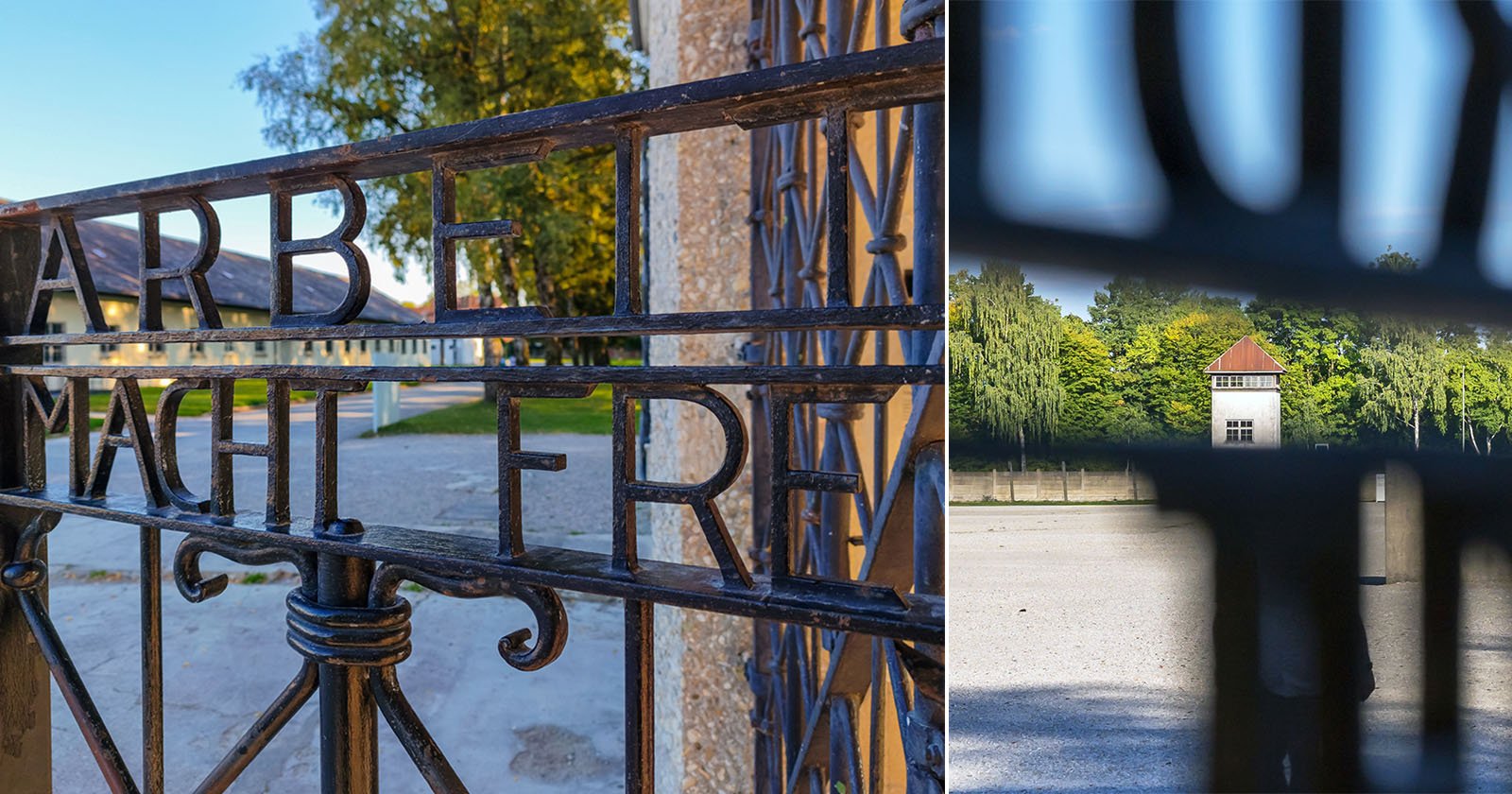Copyright PetaPixel

Nazi concentration camps have long been documented in all forms of media, but stepping through the gates of one on foot makes for a very different experience. Dachau was where it all began, setting off an industrialized machine of death and depravity that would later consume all of Europe during World War II. It’s a subject I’ve studied pretty extensively in my free time throughout my adult life, so I came in knowing details. But as an open-air museum, walking through the Dachau Memorial Site lends a real perspective on the scope and reality of life in such a terrible place. Dachau saw 200,000 prisoners pass through its gates between 1933-45, with 41,500 dying there. While not explicitly a “death camp” like Auschwitz, Treblinka, or Sobibor (among others), it still harbored similar hallmarks in the form of forced labor, gallows, a gas chamber, crematoria, and horrific medical experiments. These elements, however, would change or expand over time. In the Heart of the Nazi Heartland Dachau opened as a prison camp on March 20, 1933, with the first prisoners arriving two days later. Adolf Hitler had only just become the German Chancellor seven weeks earlier. Its location in a suburb north of Munich was by design since the city was the birthplace of the Nazi party and subsequent regime. The grounds and facilities were previously a munitions plant that served the German Army during World War I. After falling into vacancy for years during the Weimar Republic (1918-33), the Nazis saw their infrastructure as an ideal blueprint for a long-term detention facility. The SS quickly took over the camp weeks into its inception and began training its own personnel there, paving the way for the brutal disciplinary administration that followed throughout the notorious system. As the first in what would become a massive network of camps, many of the practices and policies related to guard duty, punishment, and prisoner designation originated there. The first targets were political opponents — communists, liberals, social democrats, trade union leaders — soon followed by homosexuals, Gypsies, Jehovah’s Witnesses, common criminals, and “antisocial elements”. Those deemed to have a mental illness might also find themselves sent there. German Jews were not sent to the camp simply for being Jewish — at least not until Kristallnacht in 1938, when 11,000 were sent there. More came in the following years. Virtually none of these prisoners ever received formal trials or were convicted of any crime. Without due process, they had no right to court hearings, legal defense, or appeal. Nazi authorities never stipulated set prison terms, just leaving them open-ended at the discretion of the state. The SS and Gestapo treated Dachau as an extrajudicial grey area under a policy euphemistically called “protective custody”, only in this case applied to “protect” the state from the prisoner, rather than said prisoner from any individual harm. The site notes much of this in excellent detail, showcasing photos and scans of original documents, particularly inside what was called the Maintenance Building, the camp’s central hub from 1938-45. This includes a macabre photo of a widowed German businessman named Louis Schloss, who was beaten to death with a cattle whip in May 1933. It’s not clear why, but what is known is that the SS tried to pass it off as a suicide by putting a noose around his neck and stringing him up. Such was the arbitrary terror of the Nazi prison system that humiliation, beatings, or death always cast a shadow over inmates who could expect no accountability. From the Gates and onto the Grounds Prisoners actually built the “Jourhaus” main gate and guardhouse pictured below in 1936 as the main entrance/exit point. The infamous “Arbeit Macht Frei” (work sets you free) phrase on the gate served as a false and cruel sense of hope that freedom was within reach. It is true that the SS did release some prisoners between 1933 and 1938, some of whom left the country or could be re-arrested for any perceived infraction. If you walked out of there alive, you could expect Gestapo surveillance, at the very least. This guardhouse separated the outer SS camp from the inner main camp, housing the prisoners. Peering through the gate, even from a distance, it’s easy to see the roll call area where prisoners had to stand at attention for up to an hour every morning and evening, regardless of weather or physical condition. Four lines of barracks called “Blocks” separated in two rows each by the “Camp Road” running through the middle, housed the prisoners, which saw a major expansion from 1937-38. While they’re now gone, the concrete foundation remains, and numerical stones honor each by their assigned number. The onset of World War II and Nazi conquests saw foreign prisoners arrive, many of whom were special cases, including Polish clergy, Soviet POWs (prisoners of war), French resistance members, Italian partisans and military deserters (after 1943), communist and leftist leaders from occupied countries, and gentiles who harbored Jews (after 1941). There were even small numbers of American airmen and British agents held there for brief periods, though isolated from other prisoners and the camp’s more heinous activity. They were all torn down after the camp ceased operation in the post-war period, after serving as a U.S.-run detention facility for SS personnel and a refugee camp for the displaced. Two were rebuilt to the exact specifications, including the wooden bunk beds in two versions to show how overcrowding forced prisoners to sleep in squalid and diseased conditions. Initially designed to hold 200 prisoners, up to 2,000 occupied each block at the camp’s peak imprisonment during the later war years. The locker room soon became pointless because there was no way to individualize each one. Prisoners sometimes fought over access, while others risked life and limb to hide food scraps and other contraband should SS guards find out. The washroom presented other major challenges because prisoners had to rush to do their business and get outside in time for roll call each morning, often leading to overcrowding and risking punishment if a guard felt a prisoner took too long or made a mess. “Kapos”, prisoners afforded special supervisory privileges, sometimes administered the punishment. The SS often looked to common criminals and more sadistic or opportunistic prisoners as the best candidates to do their dirty work — a policy the SS would cynically duplicate in other camps. It was also unique in that it had its own locked gate, which was off-limits to prisoners during sleep time. Those suffering from diarrhea and dysentery had to use buckets in sleeping quarters that could leave a foul stench throughout the room. Documentation, Disguise, and Disgust The SS liked photography and weren’t shy about documenting life in the camp in carefully curated ways. Photos of day-to-day labor and slices of life in the barracks were actually published in local newspapers and magazines, though the press would only come under rigorous and curated visits. Intimidation and threats forced prisoners into staged scenes to legitimize the camp’s purpose to the broader public as nothing more than a humane facility protecting them from enemies of the state. That access ceased completely by the mid-30s as the camp’s security perimeter widened and watchtowers were erected to not only cast a watchful eye on the prisoners inside but also potentially curious citizens venturing too close. Trees lined around the perimeter helped shield the camp’s activities from the outside world. As forced labor, brutality, and murder became commonplace within Dachau, the SS went to greater lengths to hide it. That didn’t stop them from taking more photos, sometimes forcing prisoners to capture images under strict directions so that certain ones could be included in reports within the SS hierarchy. Since neutral bodies like the Red Cross never visited the camp, there was little concern hiding its nefarious purpose internationally. That changed as the Allies rolled through Germany in 1945. Some photos and negatives were likely destroyed when Nazis everywhere frantically burned evidence in the face of advancing Allied troops. While documents prove SS doctors performed medical experiments within the camp’s infirmary and Block 10, liberators didn’t find corroborating photos. In the waning days of the Nazi regime, it was common practice to destroy evidence of its various crimes throughout the camp system, including photo archives. The SS utilized an intricate badge system to designate prisoners, a divide-and-conquer tactic that led to them establishing an unofficial hierarchy within captivity. These labels are most widely known for the yellow Star of David for Jews, but there was also the green triangle for criminals, red triangle for political opponents, purple triangle for Jehovah’s Witnesses, and pink triangle for homosexuals. Even drug addicts and those suffering from diabetes sent to Dachau wore the black triangle — a widely used badge also assigned to Gypsies, beggars, pacifists, sex workers, and the mentally ill. The badge system evolved to include letters, bars, reverse inverted triangles, and other markings to identify everything from dual status to repeat offenses. Badges were sometimes a form of currency in the camp, as those with a green triangle could be feared for their own self-serving sadism, while those with a pink triangle were considered the lowest rung and exposed to abuse from other inmates with no repercussions. Ceasing to Exist Adjacent to the main camp lay a separate facility housing the crematoria, of which two different ones were actually built. Basically, a small shed with two ovens, the “Old Crematorium” constructed in 1940, served the purpose of cremating prisoners who died from disease, malnutrition, or execution until 1942. Dachau didn’t operate as a death camp that gassed and cremated prisoners on arrival. Select prisoners, or “burners”, operated the crematoria, a process emulated in every camp equipped with them. As overcrowding intensified and the death toll grew, prisoners were forced to build a new building called Barrack X, housing not just four crematoria, but also a waiting area, gas chamber, and execution room. Walking through the building follows a path a prisoner might have taken to their death and cremation. The Brausebad room — or “shower” — leads right into the gas chamber, a room resembling a bunker with ventilation openings in the walls and open holes on the ceiling. It takes no more than about five seconds to walk right through it, but I stood and looked around it for minutes, taking in the sheer terror of what happened there. There’s no evidence that the Nazis used the gas chamber to exterminate whole groups of prisoners in the same way other death camps did. Existing evidence points more to single prisoners or very small groups (Soviet POWs, the disabled, etc.) as a way to train personnel or experiment with other poisonous agents. Either way, the Barrack X crematoria show signs of terrible suffering based on the hooks above where inmates could be hanged and then immediately pushed into the oven upon death. A plaque on the wall memorializes four female British Special Operations Executive (SOE) agents who were executed by single shots to the back of the head on September 12, 1944, as members of the French Resistance. They were cremated in Barrack X immediately thereafter. Execution by gunshot was common at the camp. A path from Barrack X leads to a pistol range for shooting prisoners, along with another that includes a “blood ditch” to allow some victims to bleed out. Gallows in between the two crematoria facilities were only used in the early morning or late evening to hang a prisoner out of sight of others. Prisoners’ ashes also went through a hideous journey unto their own. In the early years, families of political prisoners could receive them in an urn, though without any option to ask why or how their loved one died. Bogus autopsies and falsified records usually came with these deliveries. In later years, SS men would take ashes in droves and either discard them in farmland or dump them in the Amper River near Dachau. This eventually became too difficult, leading them to bury ashes in pits on the grounds, discovered by American troops post-war and now marked by various engraved stones to remember the many unknown victims buried there. Logistics ultimately brought the crematoria to an end due to a coal shortage in February 1945. After that, 7,400 prisoners were buried in a nearby hill, exhumed a decade later, and given a proper burial. Remembrance and Reflection Sadly, I ran out of time before I could enter what’s called the Bunker (pictured from the outside). It’s not a bunker in a military sense but rather a concrete building parallel to the Maintenance Building, lined with tiny cells. Torture chambers and solitary confinement, including withholding food and medicine, were tools of the trade for SS guards, who either arbitrarily chose to execute prisoners or induce them to commit suicide. Despite the horrors, a sense of camaraderie and cultural preservation endured. There were prisoners who recorded their experiences through writing and art, some of which became valuable evidence during the subsequent Dachau Trials after the war. Teachers and clergy tried their best to pass on knowledge, including discussing history and philosophy with other prisoners. As foreigners from various countries arrived, language barriers emerged, and some worked to overcome them by teaching each other. Units of the U.S. 7th Army liberated Dachau on April 29, 1945 — just nine days before Germany surrendered to end the war in Europe — encountering 32,000 mostly emaciated prisoners, including another 2,000 corpses lying dead inside a train that had been stopped there for days. One of the more harrowing statistics is the 1,268 prisoners who died after liberation from various health issues. When the Memorial Site opened in 1965, Catholic, Protestant, Russian Orthodox, and Jewish religious memorials were built on-site between 1960-95 to honor the dead, especially since piety (real or perceived) was enough to warrant incarceration. The Dachau Memorial Site airs a film about the camp, while the optional audio guide includes testimony from a range of prisoners from different countries, speaking in their native tongues. It’s an expansive guide, covering well over 100 other points of interest throughout the complex to help add context. I spent over three hours covering the site and left feeling like I could’ve spent three more. A somber place of serenity today, the word “Dachau” instilled fear in Germany and abroad for 12 years, and it’s easy to see why after seeing it up close.



